Football/Soccer Session (Beginner): Academy 7V7 & 9V9 Tactics and Formations
Profile Summary

| Name: | Bobby Warner ODP |
|---|---|
| City: | Aurora |
| Country: | United States of America |
| Membership: | Adult Member |
| Sport: | Football/Soccer |
Description
This was created to help our 9U and 10U recreation coaches understand the 7v7 format and tactics of the game. We hope this helps provide ideas to share and useful information for you the coach to create a successful season with your team! Have a great season!
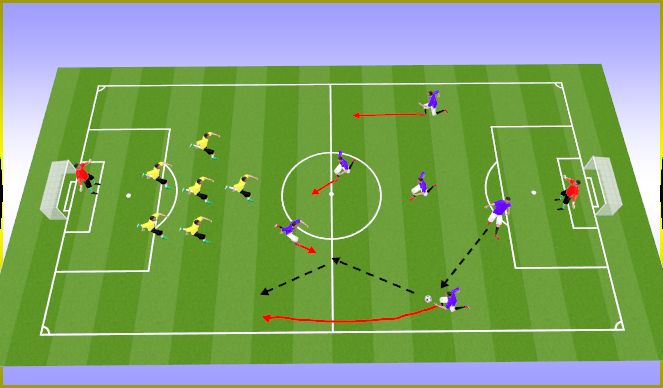
See the guidance at the top of this page to understand why you are not seeing interactive Football/Soccer images.

7v7 Formations Cont.
Here are the same formations as the last slide but showing the opposite stage of the game. The red team is collasped in and making it hard to penetrate while the blue team is opening up to create space and make it harder for the defending team. By having players stay wide as the blue team attacks will force the red team to open a bit which helps to find space to penetrate with a pass or dribble.
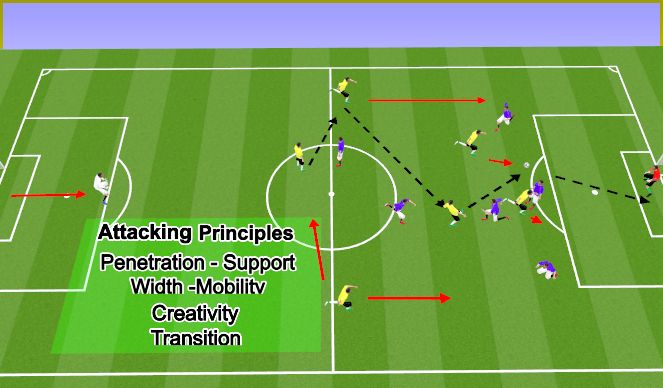
See the guidance at the top of this page to understand why you are not seeing interactive Football/Soccer images.

Attacking
Attacking Principles of Play
1. Penetration - The ability to play through or behind the opposition. Exploit space with good on and off the ball movement. IE. Can a defender find the forward with one pass.
2. Support - teammates should be available in supporting spaces ahead, to the side and behind the ball (first attacker or player in possession). This requires good dispersal when in possession to spread the field. Angles, distance and timing of movement for passing becomes important.
3. Width (spreading out when we win it) The ability to stretch our opponents laterally across the field and also provide opportunity for penetration via wide areas. Correct positioning also gives opportunities to switch the play to exploit the weak side.
4. Mobility - The ability to interchange positions and provide good movement to support the play. Movement on and off the ball to create space for the first attacker or other players.
5. Creativity - The ability to provide inventive and unpredictable play, either through individual skills or small group combinations. For example: 1vs1's, 1-2's, overlaps, feint movements, etc.
6. Transition - The moment we win the ball and the moment we loose the ball. This should be discussed so that teams can learn to recognize that when these moments occur, their recognition and action can help create options in attack or help stop the opponents counter attack when defending. Teams that react quickly to these transition moments will be more effective.
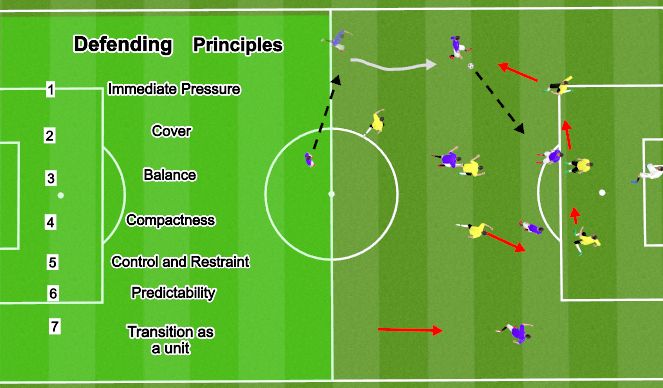
See the guidance at the top of this page to understand why you are not seeing interactive Football/Soccer images.

Defending
Defensive Principles of Play
1. Delay or immediate pressure on the ball- The ability to prevent the ball from being played forward quickly. A pressuring player needs to reduce the time and space of the attacker to prevent the ball being played forward. This is especially important when outnumbered to allow the team to re-shape to a loss of possession and dening a quick counter attack. The angle of the approach should make the game predictable for teammates
2. Cover - Defenders closest to the ball squeeze in to help win it back and provide support to the player pressuring the ball.
3. Balance - the ability of players away from the ball to restrict space in the center of the field an dto track down players making runs towards goal. Positioning is based upon the ball, players' movements and positioning on either side of the ball and the defensive posture of a team.
4. Compactness - Width and Length - the ability of players to deny opponent's space by moving as a unit. This movement is determined by the movement of the ball and attacking players, and offside space.
5. Control and Restraint- Defending players need to be patient and assess the risk involved in challenging for the ball. A well structured defending line can quickly become disorganzied with one rash challenge. Players need to exercise control and restraint and re-adjust their shape to changing scenarios. Players also need to be alert to their surroundings at all times (switched on!).
6. Predictability - When the defense is organized and compact, your team can begin to force play into safe areas of the field away from goal to provide a chance to win ball back.
7. Transition as a Unit- The speed at which players can switch roles between attach and defense within the game and individually but also as a unit.
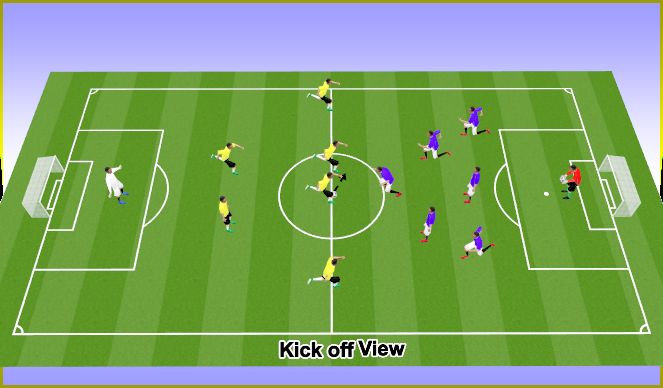
See the guidance at the top of this page to understand why you are not seeing interactive Football/Soccer images.

9U/10U Modified Rules
Modified Rules for 7v7 (6 plus 1 GK)
•One Referee- Sometimes 3 if available
•No GK punts over half field. Indirect free kick given from center circle.
•Defensive team drops to half field on all Goal kicks or restraining line like in later slide.
* Defensive team can pressure once ball is played in.
•No offside- Some associations play with offside but we do not at this age group.
•No Slide Tackles allowed in this age group.
•2 – 25-minute halves. Size 4 ball.
•Free kicks can be indirect or direct and Penalty Kicks can be awarded.
•NO heading-Indirect free kick from spot of offense.
•Substitutions are unlimited and can occur at any stoppage.
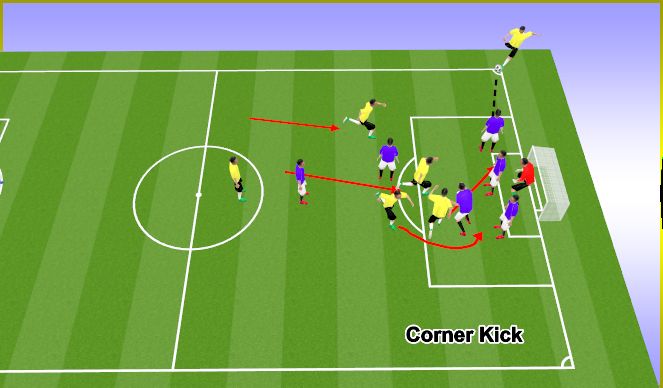
See the guidance at the top of this page to understand why you are not seeing interactive Football/Soccer images.

Corner Kick
Corner Kicks - These occur when the ball is knocked over an endline by the defending team.
The red team has players making runs to the near post, far post and center of the goal area. Also, you see a late run in from one of the defenders. This can be helpful as they are usually not marked when they come in late like this.
The defending team can decide if they want to mark man-to-man or to mark certain zones. This is a coachiing preference. Some coaches even have certain players mark zones and certain players mark man-to-man.
Defending- Clear ball out to the sides or the touchlines. Try not to clear the ball up the middle to reduce scoring chances from blocked clearences.
Attracking- Timing of the movement of the runs is an important aspect of scoring as well as good delivery of the ball. Some teams like to use short corners where you send two playes over to the corner and start with a short pass to them so that you keep possession and try to attack using the 2v1 often creates once the ball is played in fast and then you can try to create a shot or cross ball into the box.
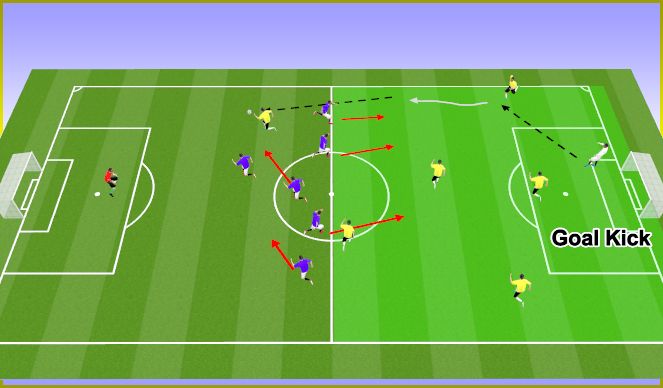
See the guidance at the top of this page to understand why you are not seeing interactive Football/Soccer images.

Goal kick
Goalkick : These occur when the ball is knocked over the endline by the attacking team while trying to score.
-Clubs can also paint a restraining line that is closer than the half field line and this is shown by the red hash lines. However, we use the half field line as we like to limit the lines on the pitch.
-At this age we require the defending team to back up to the midfield line. Once the goalkick is taken the team can step up to put pressure on the ball.







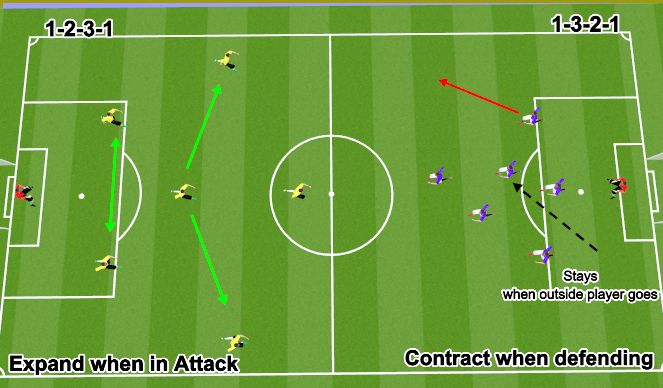
 Play animation
Play animation Play step-by-step
Play step-by-step Repeat (toggle)
Repeat (toggle) Full Screen
Full Screen Pause
Pause Stop
Stop
7v7 Formations
On this slide you have two formations and on the next slide shows the same formations just changing from attack to defense. Take a look and decide the formation you'll be playing with your team. There are other options but these are the two US soccer is recommending at 7v7. Could also use a 1-3-1-2.
Teams expand when in possession of the ball to get wide and into open spaces to allow more space and time try to keep the ball as they look to build next attack. Some coaches explain this to their team by saying Open Up or Let get big now or even Spread out
Teams contract and get smaller when they loose the ball so that they can protect the spaces infront if goal. Some coaches may explain this by saying Pinch In or Callapse. Coaches also stress for players to try to get goal side of the ball when defending to help bring more numbers back to help defend.